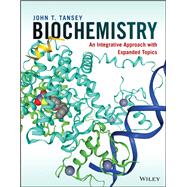Biochemistry: An Integrative Approach with Expanded Topics is addressed to premed, biochemistry, and life science majors taking a two-semester biochemistry course. This version includes all 25 chapters, offering a holistic approach to learning biochemistry.
An integrated, skill-focused approach to the study of biochemistry and metabolism
Biochemistry integrates subjects of interest to undergraduates majoring in premed, biochemistry, life science, and beyond, while preserving a chemical perspective. Respected biochemistry educator John Tansey takes a unique approach to the subject matter, emphasizing problem solving and critical thinking over rote memorization. Key concepts such as metabolism, are introduced and then revisited and cross-referenced throughout the text to establish pattern recognition and help students commit their new knowledge to long-term memory.
As part of WileyPLUS, Biochemistry includes access to video walkthroughs of worked problems, interactive elements, and expanded end-of-chapter problems with a wide range of subject matter and difficulty. Students will have access to both qualitative and quantitative worked problems, and videos model the biochemical reasoning students will need to master. This approach helps students learn to analyze data and make critical assessments of experiments—key skills for success across scientific disciplines.
- Introduces students in scientific majors to the basics of biochemistry and metabolism
- Integrates and synthesizes topics throughout the text, allowing students to learn through repetition and pattern recognition
- Emphasizes problem solving and reasoning skills essential to life sciences, including data analysis and research assessment
- Provides access to video walkthroughs of worked problems, interactive features, and additional study material through WileyPLUS
This volume covers DNA, RNA, gene regulation, synthetic proteins, omics, plant biochemistry, and more. With this text, students studying a range of disciplines are empowered to develop a lasting foundation in biochemistry and metabolism that will serve them as they advance through their careers.








